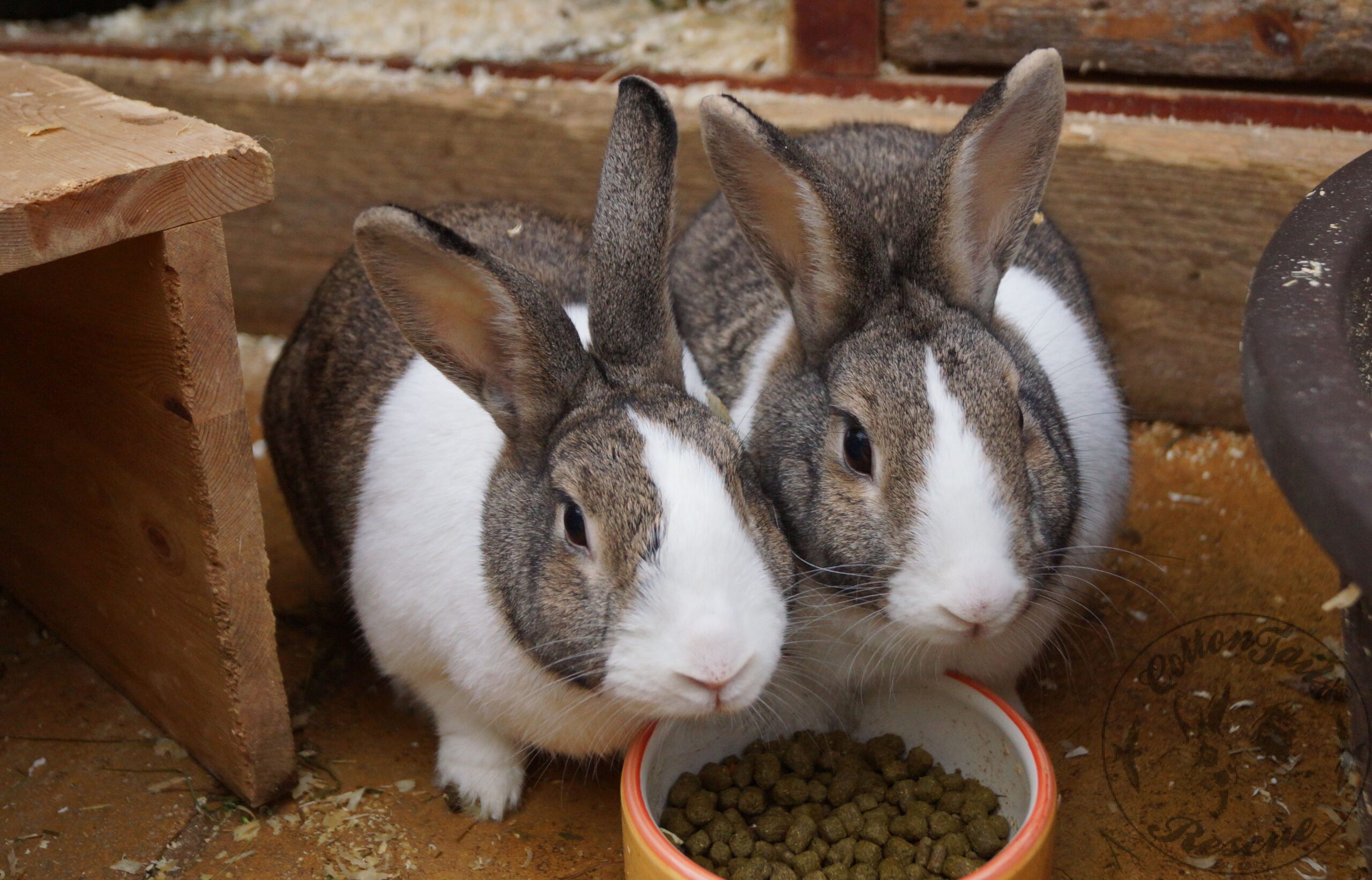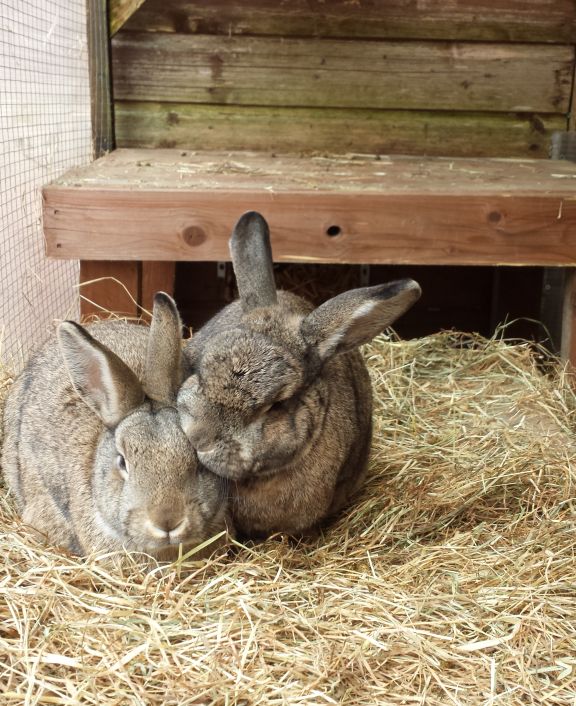You only need to open up an animal magazine or look at a rabbit website to see how much has been written about bonding rabbits, the pros and cons, and various “tried and tested” techniques for guaranteed success. If only it were that simple. Alongside this flurry of seemingly endless information have appeared some rather controversial methods of bonding where the rabbits are deliberately stressed to help them accept their new friends. Whilst none of the following examples can be condoned for obvious reasons, some of the so-called stress bonding methods include:
- Placing all the rabbits concerned into a laundry basket with a blanket on top so they can’t see
- Putting them in a tiny cage together, no bigger than 2’ x 2’
- Placing them in an empty bath
- Putting them in a bath with some cold water in (really?)
- Placing them in a carrier and then putting them on top of a washing machine during its spin cycle
These somewhat controversial techniques are balanced with methods that are widely used but still involve an element of stress:
- Taking them for a car ride in a carrier
- Walking about with them whilst they are in a carrier
- Carrying them around for a while in your arms
So, what are we doing to our rabbit’s health and well-being when they are stressed through bonding? No matter what method you choose, there will always be an element of stress involved in any match-up, regardless of how well-planned or compatible the rabbits may be. Still, keeping this stress to a minimum is important as there is no doubt that with stress comes a range of potentially harmful changes that can affect health and behaviour. See the article on bonding on the website for a complete account of how to bond rabbits.
Although trying to bond rabbits will inevitably be stressful, other factors cause stress, too, and every rabbit owner should be aware of them. Such factors include handling, pain, unfamiliar surroundings, travelling, changes in temperature or extremes of weather, loud noises, proximity of predators, and illness.
In rabbits, the perception of a dangerous, frightening or stressful situation causes the brain and the adrenal glands to release chemicals such as cortisol and adrenaline that directly affect the rabbit’s body (1). These cause a rabbit’s heart rate and blood pressure to rise, with increased blood flow to specific muscles and organs and away from those that are not essential in a dangerous situation (2). As respiration increases, the eyes dilate, the blood sugar soars and a decrease in gut motility is apparent. In the short term, such effects are advantageous as the rabbit is placed in a heightened level of awareness and can respond quicker should it need to run away from danger.
However, suppose stress persists for an extended period. In that case, this can negatively affect the rabbit, with the potential development of gut stasis, enteritis and depletion of liver energy stores. This latter point can have a devastating effect, especially on overweight or obese rabbits, and this is why such rabbits can be at higher risk of sudden death if under persistent stress. Interestingly, in a study on wild rabbits and the effects of stress, it was found that exposure to stress over 2-4 weeks resulted in a significant decline in body condition in all of them, but this was offset by an increased survival rate when released back into the wild in some (3).
An important factor in trying to minimise stress when bonding rabbits is to consider the general health of the individual and the temperament of the rabbits concerned. A study on the effects of stress on meat rabbits showed that fearful rabbits had a stronger reaction to stress than those who were more confident (4). Stress response can, therefore, vary from individual to individual. Some cannot adapt to the stressor, potentially severely affecting their health. In contrast, others adapt to the existing conditions, and symptoms such as increased respiratory rate return to normal within a short time, even if the trigger for the stress is still present.
What we all need to take away from this is that when bonding rabbits, no matter what method we choose, we must take into account the suitability of the technique with respect to the temperament and health of the individuals concerned for the best chance of success and with the least risk to the rabbits health and wellbeing. The mechanics of bonding rabbits can be fraught with problems, but the basic process is much the same whether bonding a pair or even attempting a group. Following the bonding basics below gives the matchup of two rabbits that are strangers the best possible chance of being successful:
- The best combination is neutered male with a neutered female
- Fast track and slow approach are the two basic methods of bonding – choose what suits best for your circumstances
- Do some research beforehand so you know what behaviours to expect and when to intervene
- Always introduce them on neutral territory
- They need to be living in the neutral territory for at least a week before moving them
- Do not give them too much room too quickly, as this can put a strain on the new bond
This must be done cautiously when bonding several rabbits, as severe fighting can occur. If the rabbits that you want to bond into a group already know each other visually by living in adjoining pens, the introduction may well be easier. Still, it is best to start from scratch and decide which bonding method you want to follow. Personality is arguably the most critical factor when bonding a pair or a group.
Unfortunately, it is not a trait that is easy to work out in advance, as it is only when the rabbits are together that you will see each individual’s personality type. It is common for rabbits to behave submissively with one partner and then be the dominant one with another. You need to see the interactions between all the individuals to determine what sort of personalities you are working with in that particular situation.
No matter how much we try or what methods we use, some rabbit bonding attempts will not be successful simply due to the fact they have incompatible personalities, and this is a crucial point to bear in mind as prolonged bonding attempts with such individuals will result in massive and harmful stress to all individuals concerned, including the owner!
References
1. Baias A. et al. Stress in Laboratory Juvenile Rabbits: Physiological Indicators. Scientific Papers: Animal Science and Biotechnologies, 2012, 45 (2)
2. Jenkins J.R. Frightened as a Rabbit, The Anatomy and Physiology of Fear and Stress in the Rabbit. www.drexotic.com
3. Cabezas S. et al. Physiological Stress Levels Predict Survival Probabilities in Wild Rabbits. Horm Behav. 2007 Mar;51 (3): 313-320.
4. Kowalska D. et al. Effect of Stress on Rabbit Meat Quality. Ann. Anim. Sci., 2011, Vol. 11, No. 3, 465-475


